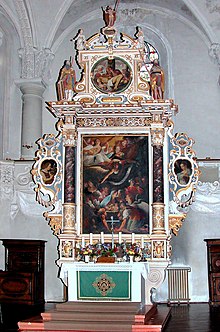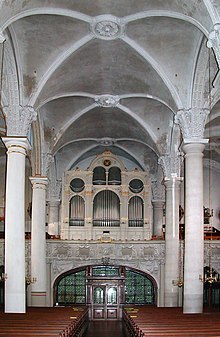St. Marien (Marienberg)
The St. Marien Church in Marienberg is an Evangelical Lutheran church in the southeast of the Erzgebirge district . It is the youngest of the three late Gothic hall churches in the Ore Mountains .
Architecture and building history
After the town's Protestant Christians received a blockhouse church in the year of the Reformation in 1537 , it was demolished for the new construction of the Marienkirche. After the foundation stone was laid in April 1558, the new church was consecrated in February 1564 . Construction management was started by Wolf Blechschmidt from Pirna and was taken over by Christoph Kölbel from Plauen in 1560. During a city fire on August 31, 1610, the church building burned down to the outer walls, the tower and the later sacristy. From 1611 to 1616 it received a ceiling, pillars and galleries made of wood. From 1616 services were held again in the church and the triumphal cross was erected. A new altar was erected in 1617. The wooden pillars and the wooden ceiling were replaced from 1669 to 1675 by Andreas Klengel with Tuscan stone columns and cross vaults with stuccoed ribs.
The hall of the ashlar building is 45 meters long and 26 meters wide and has an irregular choir, closed on five sides , on which the old sacristy with a curtain arched window and door is located. The three naves are the same height. The choir and hall have high two-storey and four-lane arched windows with tracery and a rich profile. Renaissance forms can be seen in the console cornice under the eaves. The high gable roof is provided with many dormers grouped in a triangle. The onion dome of the west tower, flanked by two stair towers, dates from 1616. The elaborately designed portal on the west side dates from the time before the fire and features staggered keel arches and bars.
In the former baptistery there is a free rib with a portrait head characteristic of Blechschmidt. In the left tower vestibule, next to Blechschmidt's stonemasons, there are probably pictures of Elector August and his wife Anna , who gave the building rich gifts, and other stonemason's marks.
Interior design
The star vaults in the vestibule and the two adjoining rooms come from the first construction phase. A pointed arch portal with bars leads to the tower staircase. The vault of the clear seven-bay hall is characterized by the stucco in baroque forms despite its Gothic arch. Free-standing acanthus tendrils, partition arches and the belt arches of the side aisles with stucco acanthus ornaments are located above the head of the mighty columns . The stuccoed cloth hangings, fruit cords and 25 angel heads on the parapets of the surrounding galleries were made under the direction of the Italian plasterer Alessandro Pernasione, who was commissioned by the chief builder Wolf Caspar von Klengel . The organ loft from 1896 is said to have been "adapted to be less than successful" . The rib vault of the sacristy on the east side dates from 1558 to 1560.
Furnishing
The authors of the art guide Dehio-Sachsen II emphasize the “extensive equipment of z. T. high artistic value ” .
Main altar
The richly decorated altar has a wooden column structure and scrollwork decoration by Andreas Hellmert from 1617. The Mannerist pictures come from Kilian Fabritius , electoral court painter in Dresden. In the predella the Lord's Supper is depicted, in the main field the birth of Christ, in the essay the Entombment and in the cheeks the Annunciation. The donkey's halter reads: “DAMNARE POTEST QUI MELIORA FACIT” (censure anyone who does better). The year 1616 appears on the dog's collar. The figures of Moses and John the Baptist above the main field probably date from the 16th century.
Other equipment
The sandstone pulpit with stairs, a simple foot and rich fittings ornamentation was made after 1610. The sound cover from 1896 bears the Latin inscription: "QUI EX DEO EST VERBUM DEI AUDIT Johann 8" (He who comes from God hears God's word). The font made of Crottendorfer marble from 1860 was donated by an anonymous donor from the parish.
During the renovation and color redesign of the nave in 1896, seven stained glass windows from the Zittau company Türcke were installed, on which Christ is depicted as the judge of the world. In 1954 the interior was given a gray color.
The life-size crucifix dates from the middle of the 17th century. The two life-size wooden miners' figures were made in 1687 and were formerly caryatids on the miner's pew. The two miner's chandeliers date from 1614 and 1743.
The late Gothic carved altar in a Freiberg workshop was made at the beginning of the 16th century and comes from the church in Lengefeld, which was rebuilt from 1724 to 1729. In the middle shrine Mary is depicted between Peter and Paul, the Passion on the inside of the wings and the Evangelists on the outside. The grand pianos probably come from the workshop of Michael Wohlgemut . The altar was restored and put up again in April 2001.
The small carved altar with Anna selbdritt comes from the Marienberg Fabian Sebastian Chapel , which was built near the Zschopauer Tor shortly after the city was founded. In the side wings, the patron saints of the mining industry Barbara and (probably) Katharina are depicted. The expressive, realistic wooden sculptures by an unknown master were made around 1520. The exterior painting with the patron saints Fabian and Sebastian is almost completely destroyed.
The memorial erected in 1924 for the fallen soldiers of the First World War was made by the Chemnitz sculptor Bruno Ziegler .
organ
The great organ by Carl Eduard Schubert was built from 1872 to 1879. The mechanical instrument with a disposition typical of the Romantic era has 51 sounding registers on three manuals and a pedal with 3,158 pipes . The original Schubert organs are generally more toned than the organs of comparable size from Gottfried Silbermann . Schubert built the “Bordun 16 ′” stop in the main work on relatively small organs. The range of registers for the strings is richer and more varied in Schubert organs than in Silbermann. Schubert built registers that Silbermann apparently did not know, such as B. Hollow flute 8 ', Salicional 8', Flauto dolce 4 ', Dolcissimo 8', Fugara 8 'and Cello 8' (pedal). CE Schubert built two large three-manual organs (Chemnitz Castle Church and St. Marien Marienberg). Schubert provided both organs with a Barker machine (pneumatic device to facilitate the mechanical action ). While the "Barker lever" was already included in the contract in Marienberg, the Barker lever was installed in Chemnitz by Schubert a few years later.
|
|
|
|
||||||||||||||||||||||||||||||||||||||||||||||||||||||||||||||||||||||||||||||||||||||||||||||||||||||||||||||||||||||||||||||||||||||||||||||||||||||||||||||||||
- Coupling : II / I, III / I, III / II, I / P
Peal
The chime consists of four large bronze bells (c 1 , es 1 , g 1 , c 2 ) and the mountain bell known as the elf -of-the-valley.
The bells were renewed in 1796 and 1862. During the First World War, the four bronze bells were confiscated and melted down on July 16, 1917 for armament purposes. The Marienberg factory owner Gerhard Baldauf then donated three new chilled cast iron bells to the church (d 1 1950 kg, f 1 1400 kg and a 1 500 kg); the bells cast by Schilling & Lattermann in Apolda were lifted in December 1918. Until the 1950s, the elf-of- the- valley also served as a fire bell for the town of Marienberg. The elf-of-the-valley has been rung by a linear motor since 2014. In 2015 the church council decided to install a new four-bell ring made of bronze bells. The costs of € 400,000 were covered to 80% from the program for the protection of urban monuments in the area of the eastern historic old town and 10% from the city budget.
In 2017, a new ring anchor was poured at a height of 45 m and the construction of a new belfry began. The new bells were cast on March 17, 2017 by the Grassmayr bell foundry in Innsbruck .
- Christ bell c 1 2700 kg Solus Christ
- Prayer bell it 1 1400 kg Sola Fide
- Revelation bell g 1 1,200 kg Sola Sriptura
- Baptismal bell c 2 880 kg Sola Gratia
The two larger of the old bells were removed on June 6th; the big bell was given its new location in the cemetery and the middle bell on the city wall at Zschopauer Tor. The small cast iron bell remains in the bell tower and is hung one floor below. The bells were solemnly consecrated on September 3rd by Superintendent Findeisen and Pastor Freier, and the bells were moved in a parade from the Erzgebirge barracks to the market square. On September 25, 2017, the bells were lifted into the tower and, after the bell cage was completed, they were transported to the bell chamber. For the 500th anniversary of the Reformation on October 31, 2017, the first ringing of the four-bell is planned.
Support association and restoration
In 1991 a support association for the rescue of the church was founded, on whose initiative the church roof was renewed, the tower repaired and the portal restored from 1992 to 1996. By 2005 the outer facade, the "council windows" behind the altar and the other stained-glass lead windows of the choir and the side aisles, the original side chapels, the sacristy and the front interior of the church were based on the Quentin model (color design from 1897 ) restored.
The total investment from donations, the funding programs of the city of Marienberg , the Deutsche Sparkassenstiftung and the funds from the Evangelical Lutheran Church of Saxony amounted to around 6.5 million euros.
literature
- Georg Dehio : Handbook of the German art monuments Saxony : II. Administrative districts Leipzig and Chemnitz. Deutscher Kunstverlag, Munich 1998, p. 674f.
- Klaus Kratzsch: Evangelical Lutheran City Church St. Marien in Marienberg ( Large Architectural Monuments , Issue 514), Munich / Berlin 1997
- Wolfgang Ranft: The St. Marien Church in Marienberg. In: Sächsische Heimatblätter 52 (2006), Heft 3, pp. 264–271.
Individual evidence
- ^ Georg Dehio : Handbook of the German Art Monuments Saxony : II. Administrative districts Leipzig and Chemnitz. Deutscher Kunstverlag, Munich 1998, page 675
- ^ Georg Dehio : Handbook of the German Art Monuments Saxony : II. Administrative districts Leipzig and Chemnitz. Deutscher Kunstverlag, Munich 1998, p. 675.
- ^ Organ by Carl Eduard Schubert ( memento from February 2, 2017 in the Internet Archive ), accessed on March 27, 2014
- ^ Celebration of the 150th anniversary of the Marienberg volunteer fire brigade
- ^ Bells renewal, with sound recording of the new bells ( memento from September 3, 2017 in the Internet Archive )
- ↑ Church bells are consecrated
- ^ Bells of St. Mary
Web links
Coordinates: 50 ° 39 '1.81 " N , 13 ° 9' 56.58" O













